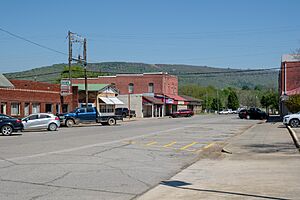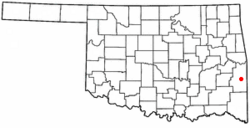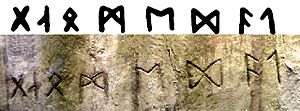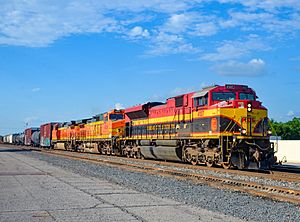Heavener, Oklahoma facts for kids
Quick facts for kids
Heavener, Oklahoma
|
|
|---|---|
 |
|

Location of Heavener, Oklahoma
|
|
| Country | United States |
| State | Oklahoma |
| County | Le Flore |
| Area | |
| • Total | 4.92 sq mi (12.74 km2) |
| • Land | 4.91 sq mi (12.71 km2) |
| • Water | 0.01 sq mi (0.03 km2) |
| Elevation | 610 ft (190 m) |
| Population
(2020)
|
|
| • Total | 2,985 |
| • Density | 608/sq mi (235/km2) |
| Time zone | UTC-6 (Central (CST)) |
| • Summer (DST) | UTC-5 (CDT) |
| ZIP code |
74937
|
| Area code(s) | 539/918 |
| FIPS code | 40-33400 |
| GNIS feature ID | 2410730 |
Heavener is a town in Le Flore County, Oklahoma, United States. In 2020, about 2,985 people lived there. Heavener is famous for the Heavener Runestone, a mysterious stone found nearby.
Contents
History of Heavener
Early Settlement and Naming
In the late 1800s, Joseph H. Heavener and other settlers came to this area. They got permission from the Choctaw Indians to farm the land. In 1880, Zachary Taylor Ward and his Choctaw wife, Tabitha Hickman Ward, moved their store here. After Zachary died, Tabitha married Joseph Heavener. They owned the land where the town grew.
Before it was called Heavener, the area had many names. Some of these included Prairie of the Tall Grass and Choctaw City. In 1895, people voted to name the town Heavener.
Growth and Railroads
The land around Heavener was good for farming, so many farmers moved there. In 1885, a cotton gin and a grist mill were built. These helped process crops.
In 1896, the Kansas City, Pittsburg and Gulf Railroad built train tracks through the town. A post office was set up in a train car. Another train car became the station. Later, in 1900-1901, the Arkansas Western Railroad also built tracks heading east.
Heavener officially became a town in 1898. Henry Moore was elected as its first mayor. By 1900, about 254 people lived there. The Kansas City Southern Railway bought the rail line in 1900. They built a large roundhouse in 1910. This made Heavener an important stop for trains. The town's population grew to 780 by 1910 and 1,850 by 1920.
Industries and Changes
In the 1930s, mining and timber became important for the local economy. A sawmill opened in 1935. The town's population reached 2,269 in 1930. However, the population then started to drop.
Things began to improve when the Heavener Charcoal Company started making charcoal. By 1970, 2,566 people lived in the town. Sadly, the sawmill burned down in 1981.
In the late 1900s, Poultry farming became very important. OK Foods opened a hatchery in 1986. They built a poultry processing plant in 1992 and a feed mill in 1995.
Heavener Runestone
Heavener is most famous for the Heavener Runestone. This stone is just outside the city in Heavener Runestone Park. It has strange symbols that look like letters from the runic alphabet. Some people believe these symbols were carved by Norsemen from long ago, even before Christopher Columbus came to America.
Because of this possible connection, Carl Albert State College changed its mascot. The college is in nearby Poteau. In the early 1990s, they changed their mascot from the "Trojan" to the "Viking."
Geography
Heavener covers about 4.9 square miles (12.7 square kilometers). Most of this area is land, with a very small part being water.
Local Media
Heavener used to have a small weekly newspaper called The Heavener Ledger. It started in 1904 but stopped publishing in 2014. There is also a radio tower for KPRV FM radio nearby. KPRV broadcasts from Poteau, a town close to Heavener.
Economy
The CPKC railroad is a very important part of Heavener's economy. It has a large train yard, a place for train crews, and a fueling station. The railroad and its older companies have been the biggest employers in town for over 70 years.
The second largest employer in Heavener is OK Foods. Since 1988, this company has run a plant that processes poultry, a mill that makes chicken feed, and a hatchery where baby chicks are born.
Schools
All the schools in Heavener are located in the center of the city. The mascot for Heavener High School is The Wolves. Their school colors are purple and gold. Students at the high school can join many activities. These include band, choir, football, cheerleading, basketball, baseball, softball, and drama. They also have academic teams and a jazz band.
Population Information
| Historical population | |||
|---|---|---|---|
| Census | Pop. | %± | |
| 1900 | 234 | — | |
| 1910 | 780 | 233.3% | |
| 1920 | 1,850 | 137.2% | |
| 1930 | 2,269 | 22.6% | |
| 1940 | 2,215 | −2.4% | |
| 1950 | 2,103 | −5.1% | |
| 1960 | 1,891 | −10.1% | |
| 1970 | 2,566 | 35.7% | |
| 1980 | 2,776 | 8.2% | |
| 1990 | 2,601 | −6.3% | |
| 2000 | 3,201 | 23.1% | |
| 2010 | 3,414 | 6.7% | |
| 2020 | 2,985 | −12.6% | |
| U.S. Decennial Census | |||
In 2000, there were 3,201 people living in Heavener. There were 1,113 households, which are groups of people living together. About 34% of these households had children under 18. Many people in Heavener are White, Native American, or Hispanic/Latino.
The average age of people in Heavener in 2000 was 31 years old. The mayor of Heavener is Troy Dyer.
See also
 In Spanish: Heavener (Oklahoma) para niños
In Spanish: Heavener (Oklahoma) para niños



